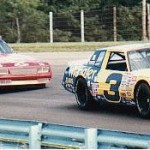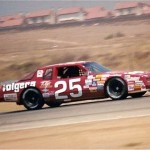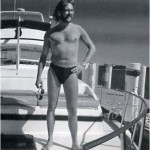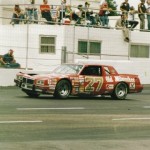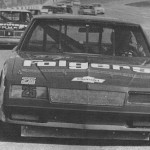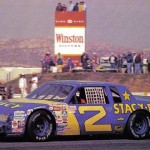Live fast and die young in a nice pair of shorts – Tim Richmond in the 1980s
The 80s truly were a bodacious time. Hammer pants abounded, Ahnold and Sly were at their finest and Tim Richmond was tearing up the NASCAR circuit door to door with Dale Earnhardt. Tim Richmond perfectly embodied the spirit of the 80s; a wild and hedonistic rock star figure, living his life just as fast off the track as on. So outrageous was his life that even Hollywood thought some events too improbable to portray in the character they based on him – Cole Trickle, from Days of Thunder. His story is that of a shooting star; burning so brightly as to be unforgettable, despite its brevity.
“A driver wrecks and finds his car damaged so badly it won’t drive forward? He whirls it around and backs it around the track and into his pit? His crew makes quick repairs and the driver roars back onto the track, winning the race by an eyelash at the checkered flag? Yeah, right.” – Poole, 2005
Born into affluence in 1955, Richmond had a privileged upbringing; “At 13, he took flying lessons, and when he turned 16, his parents gave him a car, a boat and his own plane” (Gross, Grant, 1990). He was introduced to cars early through his father and quickly developed an affinity for racing. In 1980 he was named Rookie of the Year at the Indianapolis 500. After a tumultuous time in single seaters, during which he walked away from several immense crashes; “at Michigan I cut one in two” (Richmond, from Moses, 1987), he moved to stock car racing – NASCAR.
“Truly, Trickle was a wimp and a wallflower compared to Richmond.” – Hinton, 2009
Richmond’s career in NASCAR took off relatively slowly in 1981, as he struggled to find his place in a team he could call home. He achieved his first stock car victory in 1982 in the Budweiser 400 at Riverside and another in the final race of the year. This performance earned him the respect of Raymond Beadle and a position in the Blue Max team that he would hold until the close of the ‘85 season.
It was not until he was paired with Rick Hendrick in 1986 that his career truly skyrocketed. Hendrick saw through Richmond’s hedonistic lifestyle to his raw potential as a racer; “He was a natural. He showed raw talent and car control while being aggressive” (Hendrick, from Bradley, 2009). More than anything, more than driving itself; Richmond loved to race. He was on the track to win; “I have more drive to win than anybody out there. Not just as much. More.” (Richmond, from Bradley, 2009). His fearless determination to win made him exhilarating to watch and his battles with Earnhardt will go down in history as some of the best.
Richmond’s flamboyant sense of style and wealthy upbringing put him at odds with the conservative NASCAR culture of the time. There were rules and expectations to conform to and Richmond wasn’t particularly interested in any of it. He was Hollywood in the South and it showed.
All the more interesting then that he formed such a strong bond with Dale Earnhardt. Earnhardt was a perfect example of the NASCAR model; “Dale, when he got out of the car, I think he was going back to the farm and he went… kinda down undercover and Richmond was everywhere from Hollywood to New York having a good time” (Hendrick, 2009). The two won each other’s respect door to door, bumper to bumper, on the racetrack.
Richmond was an antihero; flawed, morally complex and brilliant. He burned the candle at both ends, rebelled against the authorities and drove like the devil was on his tail. He also had a kind and giving side, giving away both his time and money to those who would benefit from it; “Barry Dodson… tells of the driver finding an old man scavenging for food under the Dover racetrack grandstands in Delaware. Richmond took him to a restaurant and bought him a steak, and when the old man wept because he had no teeth, Richmond bought him a second meal more to his liking” (Gross, Grant, 1990). His explosive racing style and these Robin Hood like moments enamoured him to the fans and frustrated the NASCAR bosses.
“The 1986 Winston cup stock car championship season is over. The man who is champion: Dale Earnhardt. Its most successful driver is Tim Richmond.”
Just like Cole Trickle and Harry Hogge in Days of Thunder, Richmond and his crew chief Harry Hyde took some time to understand each other. Once they did, however, it was magic. Richmond saw his first victory with the team at Pocono, a favourite of his and followed it up with another six wins. His stats for the 1986 season: 7 wins, 8 poles, 17 top 10 finishes and 1006 laps led from 29 starts. Counting from that first win at Pocono he went 7 for 17.
“He would’ve been good for the sport. He definitely would’ve been a champion – Rick Hendrick”
Unfortunately the world will never know if that magic ‘86 season would have turned into championships for Tim Richmond, because his hedonistic lifestyle had caught up to him. At the end of 1986 he was diagnosed with acquired immune deficiency syndrome, AIDS, contracted through heterosexual sex.
The diagnosis was kept secret and press were told that he was suffering from a burnout after the mammoth ‘86 season and was struggling to fight off double pneumonia. Richmond missed the beginning of the ’87 season while Earnhardt cleaned up – winning six from eleven races. He made his comeback at the Miller High Life 500 at Pocono and won; “he almost missed the checkered flag, his eyes were so full of tears.” (Moses, 1987). He won again the next week at Riverside, but it would be his last time at the top of the podium.
Richmond resigned from the team in September of 1987, his health having deteriorated to the point where he could no longer race. Rumours about the cause of his poor health were circulating steadily, citing drugs, alcohol and AIDS, but they were denied by Richmond. NASCAR continued to see him as a nuisance and sought to have him off the circuit. In 1988 he planned a comeback for the Daytona 500, but before he could race he was to submit to NASCAR’s first official drug test. In the lead-up to the test he stopped taking his AIDS medication so that he knew he would be clear when the time came. When the results came in NASCAR insisted they showed drugs from their list of banned substances in Richmond’s system. Richmond disputed the claim and took a second test, which he passed. In 1988 Richmond filed a lawsuit citing deformation of character and it was shown that only over the counter cold medicine had been discovered. The damage had been done, however and Richmond never raced again.
On the 13th of August, 1989, Tim Richmond died in his sleep. Possibly the biggest tragedy of Richmond’s ‘Live fast die young’ story is not that he died so young, but how he died and how he was treated by NASCAR throughout. Richmond was avant garde in many ways, an outlier in the NASCAR field who was not afraid to push boundaries and wrinkle feathers.
NASCAR and everyone in the travelling circus that surrounds it are better off for him.
Check out some more footage of Tim Richmond in action:
- 1986 Winston Western 500 post race
- Continuing an interview… after the race has gone green again.
- The Life And Times of Tim Richmond – ESPN
- Tim Richmond Remembered – ESPN
Images courtesy of:
References:
Bradley, C. (2009) ‘The Real Cole Trickle – Tim Richmond: the True Story Behind NASCAR’s Hollywood Hellraiser’ Autosport December 17 – 24 vol 198 No 12.
Gross, P. & Grant, M. (1990) ‘Racer Tim Richmond Set Records Aplenty, but His Lovers Now Fear That Aids Will Be His Real Legacy’, People Magazine January 08, 1990 Vol. 33 No. 1
Hinton, E. (2009) ‘More than Tim Richmond Died in 1989’ ESPN.com
Karpf, R. (2009) NASCAR: The Ride of Their Lives MTV [Documentary Film]
Moses, S. (1987) ‘Fit, Fast and Feisty: After an illness, Tim Richmond is winning again’, Sports Illustrated July 20, 1987 Vol 67, No. 3
Poole, D. (2005) Tim Richmond: The Fast Life and Remarkable Times of NASCAR’s Top Gun, Sports Publishing LLC

